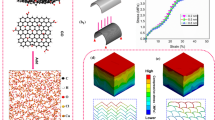Abstract
The use of high-energy ions or clusters to bombard graphene is emerging as a new method for the theoretical study of graphene properties. In this study, using molecular dynamics simulations and empirical potentials, the behaviors of graphene after bombardment by C60 under different initial velocities from 13.7 to 15.7 km/s were investigated. The simulations showed four types of defects: Stone–Wales defects, single vacancy defects, multiple vacancy defects, and out-of-plane carbon adatoms. The self-healing phenomenon of defective graphene was observed. In the low-speed region (< 14.5 km/s), the self-healing ability of graphene is enhanced at higher temperature. However, the effect of temperature is not obvious in the high-speed region, where velocity dominates. To repair vacancy defects in graphene, a physical method was proposed. The initial positions of lost atoms were traced, and then, the atoms were slowly dropped into the vacancy defects to effect repair. The simulations provide a fundamental understanding of bombardment between graphene and C60 and propose a new method for repairing vacancy defects in graphene.






Similar content being viewed by others
References
Novoselov KS, Geim AK, Morozov SV, Jiang D, Katsnelson MI, Grigorieva IV, Dubonos SV, Firsov AA (2005) Two-dimensional gas of massless dirac fermions in graphene. Nature 438:197–200
Lee C, Wei X, Kysar JW, Hone J (2008) Measurement of the elastic properties and intrinsic strength of monolayer graphene. Science 321:385–388
Stankovich S, Dikin DA, Dommett GHB, Kohlhaas KM, Zimney EJ, Stach EA, Piner RD, Nguyen SBT, Ruoff RS (2006) Graphene-based composite materials. Nature 442:282–286
Bellido EP, Seminario JM (2010) Molecular dynamics simulations of folding of supported graphene. J Phys Chem C 114:22472–22477
Zhang Y, Tan YW, Stormer HL, Kim P (2005) Experimental observation of the quantum hall effect and Berry’s phase in graphene. Nature 438:201–204
Son YW, Cohen ML, Louie SG (2006) Half-metallic graphene nanoribbons. Nature 444:347–349
Heersche HB, Jarillo-Herrero P, Oostinga JB, Vandersypen LMK, Morpurgo AF (2007) Bipolar supercurrent in graphene. Nature 446:56–59
Sreeprasad TS, Berry V (2013) How Do the electrical properties of graphene change with its functionalization? Small 9:341–350
Rajasekaran G, Narayanan P, Parashar A (2016) Effect of point and line defects on mechanical and thermal properties of graphene: a review. Crit Rev Solid State 41:47–71
Mortazavi B, Ahzi S (2013) Thermal conductivity and tensile response of defective graphene: a molecular dynamics study. Carbon 63:460–470
Liu L, Miaoqing Q, Yibo W, Shimou C (2015) Defects in graphene: generation, healing, and their effects on the properties of graphene: a review. J Mater Sci Technol 31:599–606
Lherbier A, Dubois SMM, Declerck X, Niquet YM, Roche S, Charlier JC (2012) Transport properties of 2d graphene containing structural defects. Phys Rev B 86:075402–075411
Ping Y, Li XL, Zhao YF, Yang HY, Wang ST (2013) Effect of triangular vacancy defect on thermal conductivity and thermal rectification in graphene nanoribbons. Phys Lett A 377:2141–2146
Zandiatashbar A, Lee GH, An SJ, Lee S, Mathew N, Terrones M, Hayashi T, Picu CR, Hone J, Koratkar N (2014) Effect of defects on the intrinsic strength and stiffness of graphene. Nat Commun 5:3186
Xu ZC, Zhong WR (2014) Probability of self-healing in damaged graphene bombarded by fullerene. Appl Phys Lett 104:261907
Zhu J, Shi D (2013) A possible self-healing mechanism in damaged graphene by heat treatment. Comput Mater Sci 68:391–395
Galashev AY, Rakhmanova OR (2015) Computer simulation of the bombardment of a copper film on graphene with argon clusters. Chin Phys B 24:105–108
Zhao S, Xue J, Li L, Wang Y, Yan S (2012) Drilling nanopores in graphene with clusters: a molecular dynamics study. J Phys Chem C 116:11776–11782
Li W, Li L, Zhao S, Zhang S, Xue J (2013) Fabrication of nanopores in a graphene sheet with heavy ions: a molecular dynamics study. J Appl Phys 114:183–191
Bellido EP, Seminario JM (2012) Molecular dynamics simulations of ion-bombarded graphene. J Phys Chem C 116:4044–4049
Bai Z, Zhang L, Li H, Liu L (2016) Interfaces, nanopore creation in graphene by ion beam irradiation: geometry, quality and efficiency. ACS Appl Mater Int 8(37):24803–24809
Bai Z, Lin Z, Ling L (2015) Bombarding graphene with oxygen ions: combining effects of incident angle and ion energy to control defect generation. J Phys Chem C 119:26793–26802
Dreyer DR, Park S, Bielawski CW, Ruoff RS (2009) The chemistry of graphene oxide. Chem Soc Rev 39:228–240
Mao S, Pu H, Chen J (2012) Graphene oxide and its reduction: modeling and experimental progress. ChemInform 2:2643–2662
Pei S, Cheng HM (2012) The reduction of graphene oxide. Carbon 50:3210–3228
Eda G, Chhowalla M (2010) Chemically derived graphene oxide: towards large-area thin-film electronics and optoelectronics. Adv Mater 22:2392–2415
Brenner DW (1990) Empirical potential for hydrocarbons for use in simulating the chemical vapor deposition of diamond films. Phys Rev B 42:9458–9471
Yao Z, Wang JS, Li B, Liu GR (2005) Thermal conduction of carbon nanotubes using molecular dynamics. Phys Rev B 71:085417
Acknowledgments
This work was supported by the National Natural Science Foundation of China (Grant Nos. 51761004, 61264004, and 51661005), the Guizhou Province Science and Technology Fund (Grant No. J[2015] 2050, and [2017] 5788), and the Cooperation Project of Science and Technology of Guizhou Province (Grant No. LH[2016] 7430).
Author information
Authors and Affiliations
Corresponding author
Additional information
Publisher's Note
Springer Nature remains neutral with regard to jurisdictional claims in published maps and institutional affiliations.
Rights and permissions
About this article
Cite this article
Luo, J., Gao, T., Li, L. et al. Formation of defects during fullerene bombardment and repair of vacancy defects in graphene. J Mater Sci 54, 14431–14439 (2019). https://doi.org/10.1007/s10853-019-03938-2
Received:
Accepted:
Published:
Issue Date:
DOI: https://doi.org/10.1007/s10853-019-03938-2




